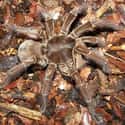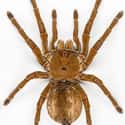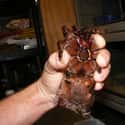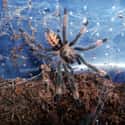-
(#7) Despite The Name, They Mostly Eat Worms
While it's true Goliath birdeaters attack and eat small birds, they rarely manage to catch avian prey in the wild. In fact, they subsist primarily on worms, supplemented with typical giant spider fare such as insects, lizards, frogs, toads, and even the occasional snake.
-
(#5) Like All Tarantulas, Their Eyesight Is Terrible
Despite what you may surmise from looking at them, Goliath birdeaters are not perfect killing machines. Like all tarantulas and most spiders, they have incredibly poor eyesight. To make up for this, tarantulas hunt by sensing vibrations on the ground. When they feel something, they pounce on their prey and subdue it with venom.
Tarantulas make up for poor eyesight by hunting at night, putting them on equal footing with anything that isn't an owl. Or Predator. But why would a tarantula hunt Predator?
-
(#1) It's The Most Massive Spider Species In The World
It should be no surprise a spider that can eat birds is huge. The Goliath is (quite literally) massive. It is the largest spider in the world in body size and mass. Its body length can reach 11.9 cm (about 4.5 inches) in length; some Goliath birdeaters have been known to reach lengths of 11 inches, which is about as big as a dinner plate.
Goliath birdeater leg span can reach 28 cm, and the spiders weigh around 175 grams, which is a little less than half a pound (what do you want, it's a spider, not an elephant). The only larger spider by any measure is the giant huntsman, which has a longer leg span.
-
(#3) They Shoot Tiny Barbed Hairs From Their Abdomen As A Defense Mechanism
When threatened, Goliath birdeaters can shoot tiny, barbed hairs (called urticating hairs) from their body. These extremely tiny hairs irritate to the skin, and can get caught in the eyes, nose, and mouth to great agitation of the attacker; they are especially damaging to soft, exposed areas with mucous membranes, such eyes.
-
(#4) Males Die Not Long After Mating
Male Goliath birdeaters typically die a few months after mating, having fulfilled their biological function. The female spins a web, lays 50 to 200 eggs in that web, gathers the web into a ball, and carries it around. Carrying the egg sac makes Goliath birdeaters unique among tarantula species.
-
(#11) Three New Species Of Birdeater Tarantulas Were Discovered In 2017
In March 2017, three new species of bird-eating spiders were discovered in the jungles of Peru, Ecuador, and Brazil by Caroline Sayuri Fukushima of the Sau Paulo Institute. The discoveries were part of a project to help better document and track tarantulas of the Avicularia genus, the classification of which Fukushima describes as "a huge mess."
These animals belong to a different genus than the Goliath birdeater, which makes you wonder how many giant birdeating tarantula species there are in the world.
New Random Displays Display All By Ranking
About This Tool
Our data comes from Ranker, If you want to participate in the ranking of items displayed on this page, please click here.
















